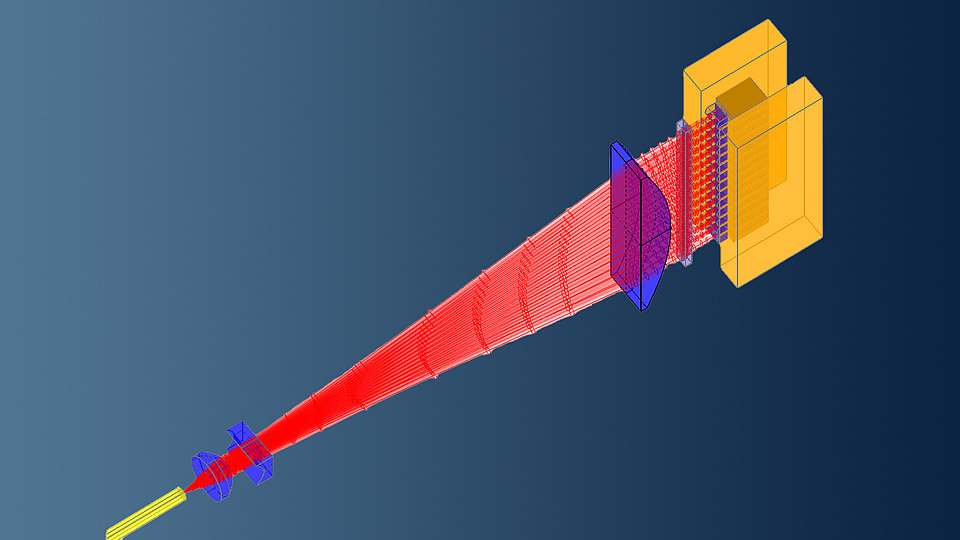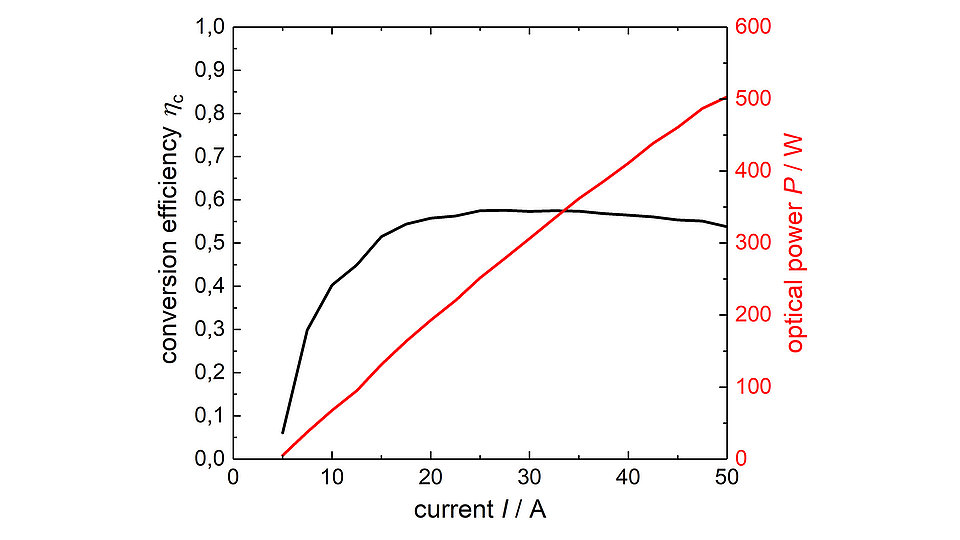Compact 976 nm pump-module for 200-µm fibers based on DBR-stabilized double-emitter stacks
Fig. 2: Measured continuous wave optical power and conversion efficiency as a function of current for a prototype stack.
One of the most common types of fiber lasers are ytterbium-doped fiber lasers, supporting the world’s largest laser market: material processing. These lasers can be especially efficiently pumped at a wavelength of 976 nm, with pump energy provided by multiple 200-µm fibers. Key factors include the provided power, price per pump module, a stable and narrow grating-stabilized spectrum, high conversion efficiency, and small dimensions of the pump sources. While several compact 200-µm fiber pump modules at 976 nm are already available, there is strong demand for technological innovation to enhance performance. FBH has developed a new design approach based on its successful side-cooled stack modules. The first prototype module concept can compete with commercial suppliers in terms of size and performance, but stands out for its especially simple and potentially cost-effective design.
Commercial pump modules of that kind typically consist of several diode lasers or laser arrays arranged side-by-side for efficient cooling. This leads to a complicated optical setup where each emitter or array must be individually collimated, requiring a large number of mirrors to combine the emitters’ beams. In addition, these modules require an external volume Bragg grating as extra optical element to achieve a sufficiently stable narrow spectrum, adding adds cost and a reliability hazard. The FBH uses its proven side-cooled stack design for efficient cooling of the individual lasers, with the emitters stacked vertically. This arrangement means that no mirrors are required to combine the beams in the vertical direction if the fast-axis collimation lenses (FACs) are selected appropriately. At the same time, it is not necessary to use a separate slow-axis collimation lens (SAC) for each emitter; instead, a single cylindrical SAC lens extending over the entire stack height is sufficient for horizontal collimation. To meet the fiber dimension in the lateral beam direction, we use two 200 µm wide broad-area lasers, both in one chip in a single stack element. The stack geometry allows a relatively large distance between the two emitters, enabling efficient cooling and lateral combination of the beams via a single suitable double SAC lens. In addition, we use lasers with an integrated DBR grating, which means that no additional VBG is required.
A schematic depiction of the optical setup is shown in Fig. 1. A prototype stack consisting of 12 DBR-stabilized double emitters (24 diode lasers) delivered a continuous wave optical power of 500 W within a narrow spectrum of 1.2 nm (95 % power content) with a conversion efficiency above 50 %, as shown in Fig. 2. Beam characterization of the collimated stack output indicates suitable beam parameters for high coupling efficiency into a 200 µm core fiber.
Publications
M. Wilkens, P. S. Basler, B. Eppich, J. Fricke, A. Ginolas, M. Hübner, P. Crump, “High-brightness pumps for fiber lasers based on monolithically grating stabilized diode lasers”, Proc. SPIE 12867, 128670L (2024). https://doi.org/10.1117/12.3002553
P. Crump, Md. J. Miah, M. Wilkens, J. Fricke, H. Wenzel, A. Knigge, “60 % Efficient Monolithically Wavelength-Stabilized 970-nm DBR Broad-Area Lasers”, IEEE Photonics J., vol. 14, no. 3, art. 1524305 (2022). https://doi.org/10.1109/JPHOT.2022.3166591


